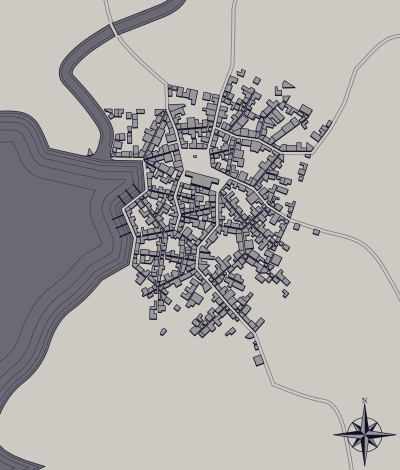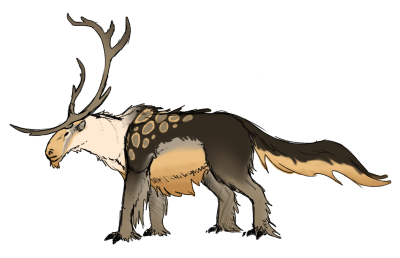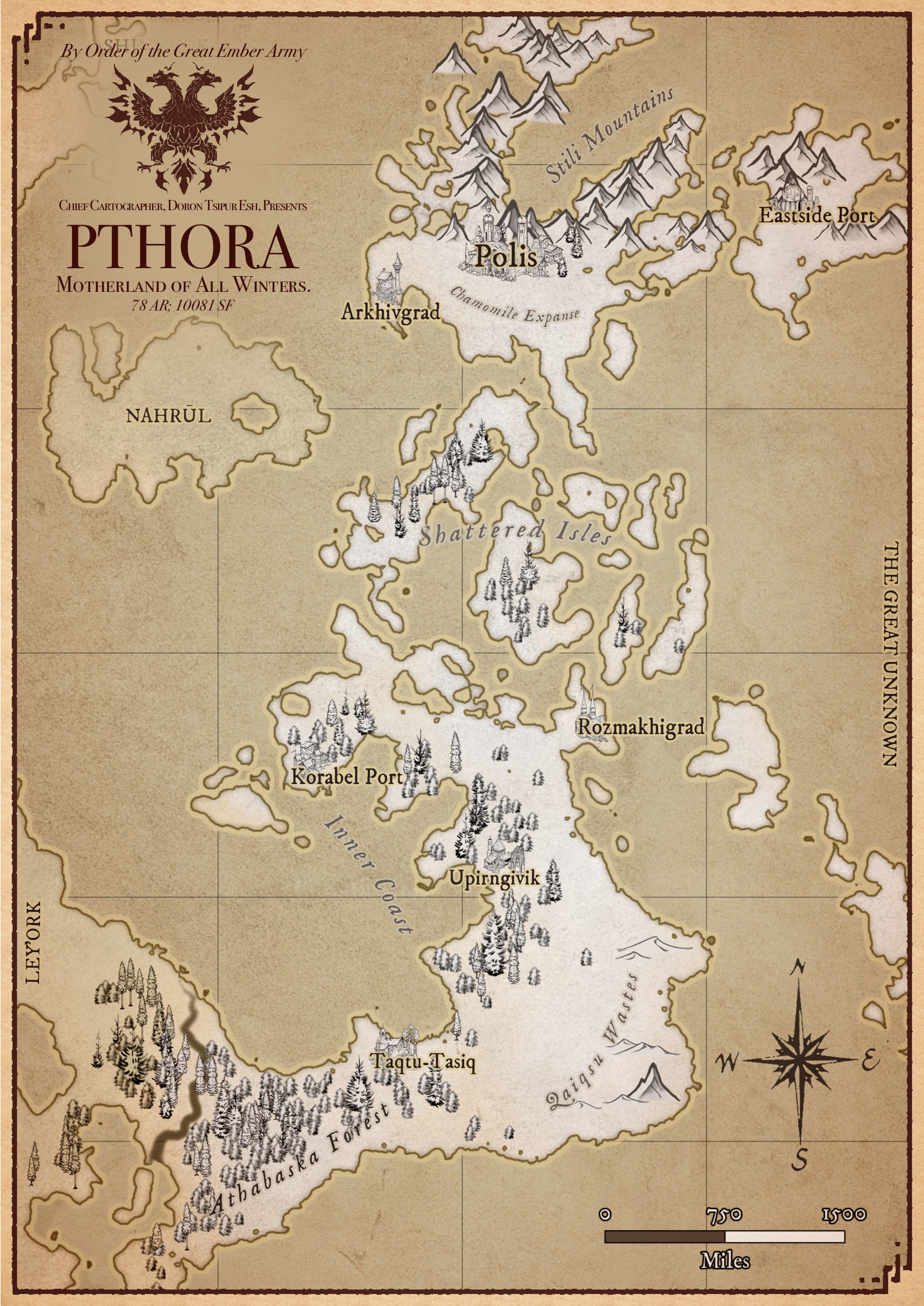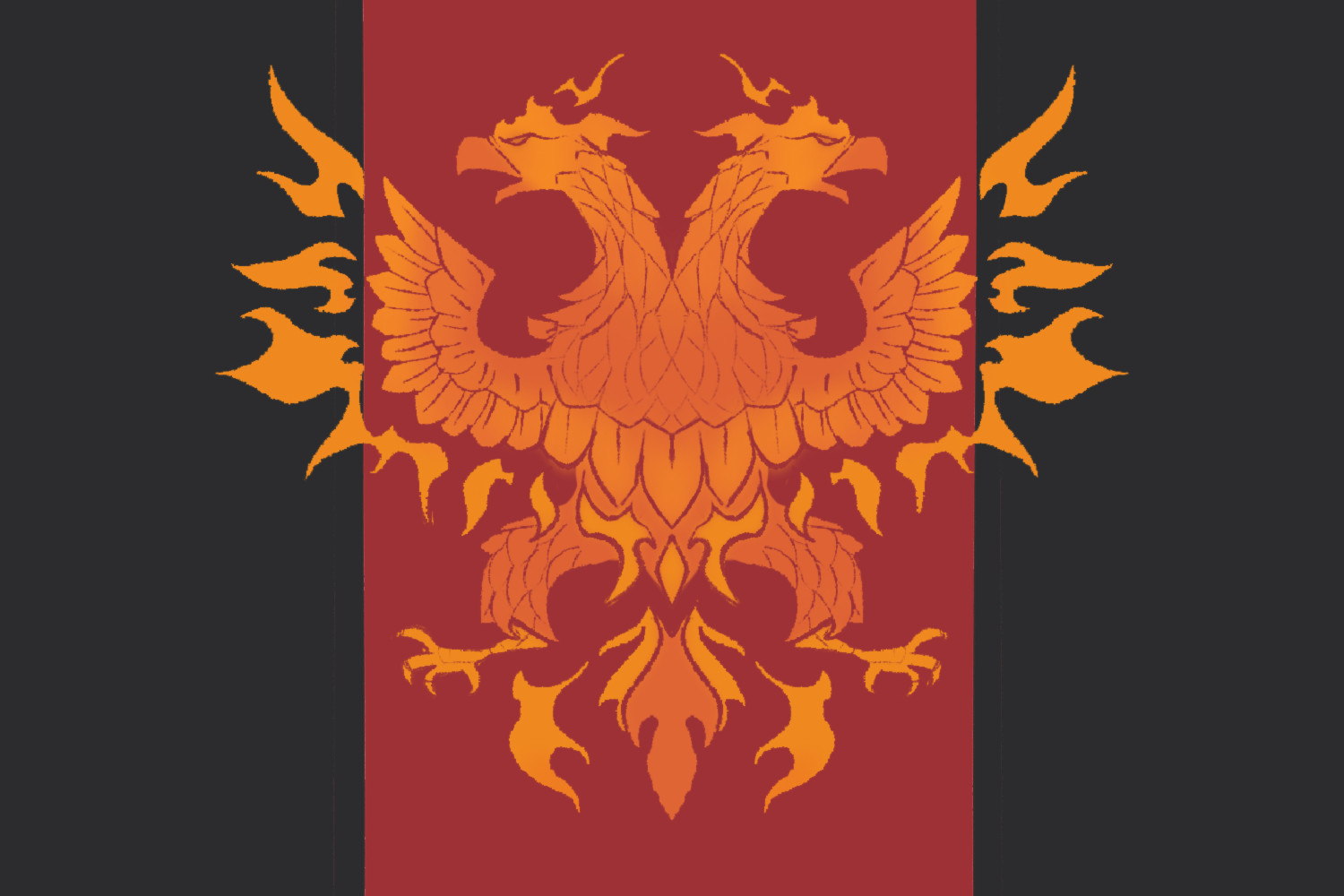Table of Contents
Pthora
- Government Type: Democratic Triumvirate
- Symbol: Firebird (previous), Wolf and Hammer
- Major Races: Dwarves, Kleemudor Lizards
- Capital: Polis
- Demonym: Pthoran
Overview
The far eastern reaches of Cahyali are a polar wasteland, to some… but to Pthora, it is home. Mostly tundra, the technical territory of Pthora spans most of the far-eastern side of the Cahyali continent, although most of their population is located only in the north. The climate of Pthora is cold year-round, with temperatures approaching temperate in the midst of summer. A mystical leyspring lies in the south, its surroundings shrouded in mystery and danger. The caretakers of this leyspring, and the indigenous people of the southern tundras are known as the Johtalit. Pthora is loosely based on the real-world country of Russia.
Since its founding, Pthora has known constant war - thousands of years ago, against the armies of Dahabu, and more recently, it has been locked in an arms race against Ley’Ork and the Oxis Alliance. In the intervening time, its struggle against the cold of the southern tundra has defined national identity. Pthora and war are entities so deeply linked that one cannot disentangle them any longer. With the largest standing army and most developed military in all of Cahyali, its martial might is a force to be reckoned with.
Natural Resources
Pthora is home to a wealth of natural resources: stone and ore, all mined from the Stili Mountains (particularly the towering Polis Peak). Most notably of these resources is a metal called adamantite, widely sought after for its easy malleability when forging, but incredible strength when cooled and set. Many of the greatest armors and weapons were constructed out of adamantite. This resource is tightly controlled by the government.
Regions
Pthora is a large country, though most of it is centralized in the northern landmass and archipelago. Southern Pthora is hardly Pthora at all, though Polis still claims dominion over the vast, forbidding tundras. Altogether, the country is broadly split into six regions.
Greater Polis Area
Polis is the largest city in Pthora, and towers above the Chamomile Expanse from where it is built into the tallest peak of the Spitl Mountains. Surrounding it, representing hundreds of years of building and civilization, is an area full of several smaller towns, as well as acres upon acres of farmland. For millennia, Pthora’s rulers have exerted their power from Polis, and its surrounding area has remained the center of Pthoran life essentially since the country’s founding.
Chamomile Expanse
The Chamomile Expanse covers most of the landmass of Pthora’s northern island, and is named as such for the bounty of chamomile flowers growing in the region over the warmer months. Despite being the warmest region of Pthora by far, few have taken up residence here, preferring the infrastructure of the Polis area. Many that resist the power of Polis have congregated here, often closer to the Nahruli coast.
Stili Mountains
This mountain range runs in a V-shape across the northern edge of Pthora. It is thought to be the initial landing point for ancestral dwarves, during Pthora’s initial settling. Though sparsely populated, sporadic towns and cities exist on the range, primarily built underground to escape the intense cold. Most notable among these is the royalist city of Vondrah, which sits upon the ruins of one of many ancient dwarven cities in the area.
Shattered Isles
The Shattered Isles are a chain of islands that connect Pthora and the tundras. In winter, one can walk from northern Pthora down to the islands, as thick sheets of sea ice form between the islands that last well into the spring. Few are sure of the true shape of the Isles, as this icy layer persists in some capacity year-round. The Isles mainly export fishing, and contain most of Pthora’s port cities. The vast majority of trade conducted with other nations goes through the Shattered Isles. The region was previously host to a large part of Pthora's oppressive prison system until it was dismantled by the Triumvirate.
Johtalit Tundra - Inner Coast
The majority of the Johtalit inhabit the western coast of Pthora, where weather is warmer and resources are more plentiful. They form few large cities, but a few sizable towns exist in the Inner Coast area. Many of these maintain good relationships with Ley’Ork, offering aid to explorers and scientists - under the condition that they remain staunchly sovereign.
Johtalit Tundra - Qaiqsu Wastes
Nothing lives in the Qaiqsu Wastes. Nothing has ever lived in the Qaiqsu Wastes. Ignore the “stars” that land here, and do not stare too long at the angry, lone mountain peak. Please. Nothing is to be gained. This is not a place of honor.
As of 2557, an adventuring party returning from a short-lived excursion to the lone peak reported that it appeared to be a perfect pyramid shape, with snow and ice building up the facade of a mountain. Ever since that excursion, Johtalit tribesmen have mused that the mountain seems a little less ominous.1)
Governance
Until recently ruled by a string of dictatorships, with the death of Katerina Zimina a new government has arisen known as the Pthoran Triumvirate. The core of this administration is a ruling council of three Triumvirs of equal power. The first of these is the monarch of Pthora, with the lost royal line restored and recently returned from their regency of Vondrah. The remaining two are elected democratically, serving for a period of 10 years. The current members of the Triumvirate are:
- King Abican Husso Angrada
- Marshal Wyrdett Volkov
- High Scholar Alneva Kakarin
The Triumvirate directly governs the city of Polis, while all other cities elect their own leadership who report to the central government. While the Pthoran military still possesses a great deal of influence, it has been officially separated from governmental administration, and military officers who are also government officials are no longer the rule, though not uncommon.
Laws
- Theft of personal property: Incarceration for up to 90 days and/or fine equal to the worth of the stolen goods.
- Theft of government property: Incarceration for up to 1 year
- Use of unlicensed dangerous magic: Incarceration up to 5 years
- Election Tampering: Incarceration for up to 5 years
- Assault: Incarceration for up to 10 years
- Embezzlement of government funds: Incarceration for up to 20 years
- Ownership of another intelligent humanoid creature: Execution or exile from Pthora for life.
- Murder & rape: Execution
- Treason: Execution, & incarceration of family members for up to 5 years
For more information on the history and culture of Pthora, follow this link: Pthora History & Overview
The national flag of Pthora under the Pthoran Triumvirate.
Cities of Pthora
Polis, Everlasting Northern Star: Population 4 million. The capital of Pthora, Polis is its largest city. Having stood for millennia, this city is carved out of the side of Polis Peak itself. It stands as a testament to Dwarven culture on Pthora, and acts as a grand facade for the might of each short-lived authoritarian regime passing through the nation. Polis is far wealthier and technologically advanced than the rest of Pthora. Its greater metropolitan region contains about 80% of Pthora's population (excluding the indigenous peoples).
- Svetagrad Town: Population 0. Located on the edge of the Polis metropolitan region is an eerie ghost town, devastated by plague in 2501. Rumor has it that eerie, frozen undead wander the rotting streets - an unnatural sight even for the undead…
- Kogot Village: Population 10,000. Once a farming village, this small settlement has recently seen an uptick in craftsmen and engineers arriving to the area, and is becoming a hotspot of experimentation and artifice in the Polis region.
Czernobog, Snow's Portrait: Population 500,000. Czernobog was once a city dedicated to producing “approved” art which venerated the Ember Army, but with the repeal on artistic censorship the underground artistic movements which existed in the city have exploded. This change is being supported by the new Pthoran government, who hope to cultivate a resurgence of Pthoran cultural identity. Czernobog is located within the greater Polis region.
Arkhivgrad, Grand Library of Renewal: Population 1 million. Far from Polis, on the western coast of the main Pthoran island, is a city built half-underground, in an effort to seem like a smaller settlement than it is. Arkhivgrad was a bastion against the Ember Army, a center of knowledge whose only hope of survival was remaining mostly undetected. But now, with a new Pthoran age dawning, the city has come into the open, its long guarded repositories of knowledge now shared with the wider nation. Even now the city's countless scholars work to patch together the frayed accounts of Pthora's history, and use old wisdom to build the new. Arkhivgrad is located near a few smaller villages, named Tvesti and Pero, which function as refugee encampments for the most part.
 Eastside Port, Gate to Mountains: Population 400,000. Located on, well, the east side of the Stili Mountains, this port city is the main access point for shipments of ores from the mountains. Cargo ships sail down the Chamomile River, passing by Polis on their way to the Inner Ocean. Despite Pthora's longstanding poor reputation on the world stage, trade has remained open from other nations - albeit with high tariffs, though the new government is working to improve the situation. Eastside is populated mainly by those who work for trading companies and their families.
Eastside Port, Gate to Mountains: Population 400,000. Located on, well, the east side of the Stili Mountains, this port city is the main access point for shipments of ores from the mountains. Cargo ships sail down the Chamomile River, passing by Polis on their way to the Inner Ocean. Despite Pthora's longstanding poor reputation on the world stage, trade has remained open from other nations - albeit with high tariffs, though the new government is working to improve the situation. Eastside is populated mainly by those who work for trading companies and their families.
Korabel Port, Gate to Seas: Population 500,000. In the southern reaches of the archipelago connecting Pthora prime and the southern tundras is Korabel Port, a large port city serving as an access point for trade with the Heartlands and the Abundant Expanse. The city's distance from Polis has meant it has possessed greater freedom from the oppressive regimes which ruled there, and many Johtalit work and reside there.
Vondrah, the Buried City: Population 100,000. Located in the Stili mountain range on the northern island of Asibye, this city was until recently the seat of the Angrada family. Built atop ancient dwarven ruins which are still being excavated, the city acts as a hub for the isolated settlements of the region. Its position atop the Null Labyrinth makes it a good place to explore the tunnel networks beneath, and deposits of mythril have been found nearby.
Rozmakhigrad, the Unshackled City: Population 60,000. This city was once the greatest prison in Pthora, where political prisoners worked forced labor in mines and doomed expeditions into the tundra. The inmates were freed when the Triumvirate came to power, but distrust in any Pthoran regime led the city to declare its independence. The city is improving its relations with the surrounding Johtalit, and has even begun to engage in trade from the town of Davikh on the Inner Coast.
Upirngivik, Anchor Point: Population 20,000. In the northern region of the Johtalit tundras is this small town, inhabited by the Johtalit. Somewhat more militarized than other Johtalit settlements, Upirngivik acts as a deterrent for Pthoran forces from entering Johtalit territory. With the rise of the Triumvirate relations have improved, but the Johtalit are still wary of the government.
Taqtu-Tasiq, Sacred Towns: Population Varies. The many towns of Taqtu-Tasiq are located on the tops of a gentle ring of hills - a place that was likely a mountain range in the distant past. In a valley at the center of these hills is a kidney-shaped lake, as well as the tundra leyspring. No people live inside the valley permanently, as it is considered a violation of sacred ground by the Johtalit.
This leyspring, flowing far more peacefully than the one in Ruefang, is a sacred site for the Johtalit. They call it Angiyok-Orpik, loosely translating to “great tree” due to the leyspring's visible nature, which resembles the massive spectral crown of a tree growing from the ground. The Angiyok-Orpik area is lush and warm year-round.
Culture
Impenetrable, Unshakable, Arrogant
Time and time again, Pthora has thrown its full weight behind a single ruler, but for the first time in centuries the situation has changed. The people are still wary of the new government, uncertain whether it will bring lasting change or devolve into simply another autocracy. Turmoil is arguably the glue that binds Pthora together; the country has hardly known life without it, but now there is a glimmer of hope for stability, and thoughts that a new national identity must be forged. New movements in culture and society have begun, looking to both the past and future for inspiration. Without the censorship of the old regimes, art and literature are flourishing openly, especially those supported by Arenti's famiglia.
The daily attire of Pthorans is still best described as austere, with most resembling military dress. Fur trimmings and soft textures are common, as guards against the cold climate. The cities themselves are grand in their construction, built onto the sides of mountain peaks - or rising like mountains out of the alpine plains. The architecture is carved from stone, with grand bearded visages adorning ceremonial and governmental buildings. Statues, built from stone or bronze, are not uncommon to see around, though those venerating the Ember Army are now being replaced with contemporary and ancient heroes.
While no longer a military state, Pthora still possesses a strong martial culture. The army still possesses a great deal of influence in the cities, and in frontier territories where it cannot reach, militias are of immense importance to defend against wild animals and monsters. Even though conscription has been brought to an end, many Pthorans still choose to join the military, with serving to defend the Motherland seen as a great honor.
Religion & Magic
Having never known Dahabi religion, Pthoran traditional belief is animistic and semi-monotheistic, believing in a great force of nature that pervades each and every part of the natural world. After the Ember Army’s takeover, religion of all forms was banned in Pthora, but now whispers of faith have begun to return. Pthoran traditional beliefs are emerging once more, and in major cities even shrines to the 13 are being built.
Magic is still regulated in Pthora, but not nearly as harshly as before. Practitioners of advanced magic must receive license from the government, with major violations leading to imprisonment. While no mage colleges currently exist in Pthora, there is discussion of beginning some in places like Polis or Arkhivgrad. Among the elemental disciplines, fire magics are most highly valued, both for their military applications and use in defending against the cold.
Southbound: Lands of Drifting Snow
Defended by their natural environment, the Johtalit people have managed to weather the blows of both Dahabi invasion and Pthoran aggression for millennia. They practice a spiritual religion, venerating nature itself as the greatest of all gods. Some of this belief is directed at deities such as Osiris and Vahrun, referred to as Beaivi and Nuliajuk, respectively. Peregrinus and Tenebrus are also worshiped as a single sky god, called Unipkaaqtuat. Seers, shamans, and healers often worship their own interpretations of Seherine, Vormaxia, and Aset - or sometimes conglomerate interpretations of the three.
The Johtalit herd large animals called snowstriders (pictured bottom right), the name going back to their origins on Kleemudor - but here used to refer to an entirely different creature. The husbandry of these creatures is central to much of Johtalit culture, as snowstriders allow them to cross the land in relative safety and also provide much-needed hides and meat. Johtalit live mostly in small villages built from wood and brick, each led by a chieftain or shaman. Few elemental mages exist among the Johtalit, with magic practice being in the realm of divine or spiritual (the Johtalit make no distinction between the two); or, occasionally, psionic.



